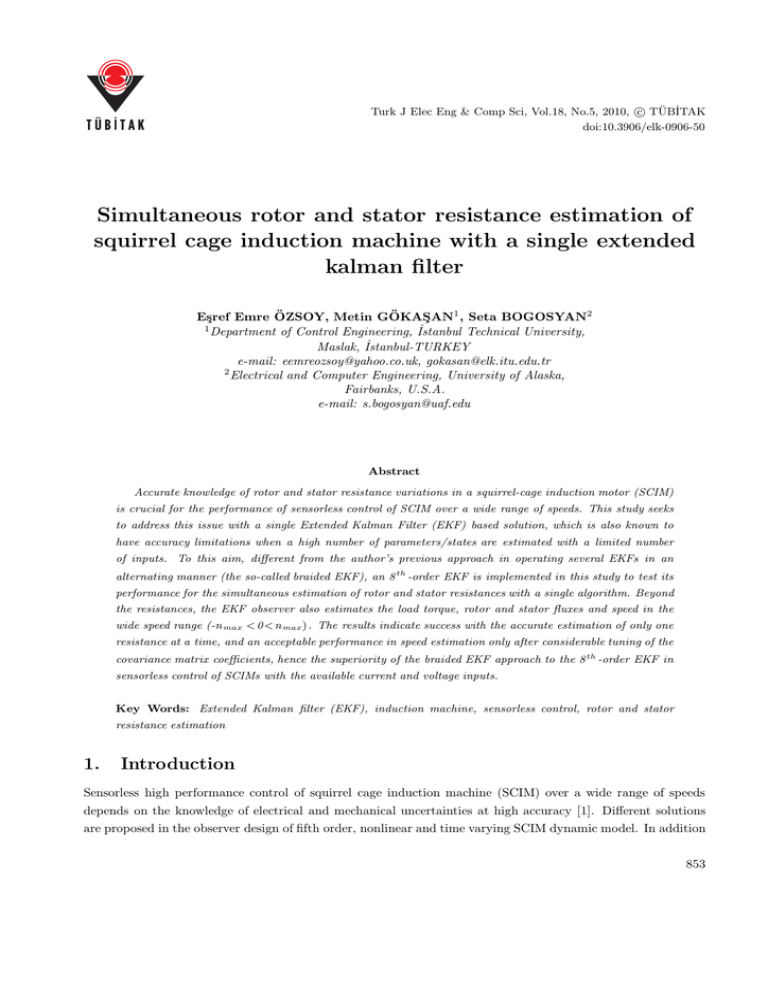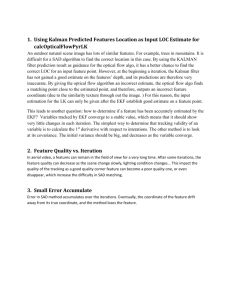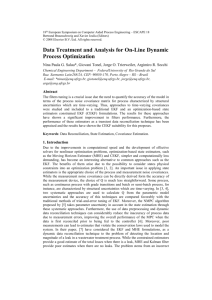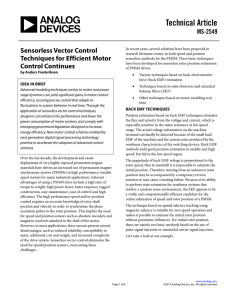Simultaneous rotor and stator resistance estimation of squirrel cage
advertisement

c TÜBİTAK Turk J Elec Eng & Comp Sci, Vol.18, No.5, 2010, doi:10.3906/elk-0906-50 Simultaneous rotor and stator resistance estimation of squirrel cage induction machine with a single extended kalman filter Eşref Emre ÖZSOY, Metin GÖKAŞAN1 , Seta BOGOSYAN2 1 Department of Control Engineering, İstanbul Technical University, Maslak, İstanbul-TURKEY e-mail: eemreozsoy@yahoo.co.uk, gokasan@elk.itu.edu.tr 2 Electrical and Computer Engineering, University of Alaska, Fairbanks, U.S.A. e-mail: s.bogosyan@uaf.edu Abstract Accurate knowledge of rotor and stator resistance variations in a squirrel-cage induction motor (SCIM) is crucial for the performance of sensorless control of SCIM over a wide range of speeds. This study seeks to address this issue with a single Extended Kalman Filter (EKF) based solution, which is also known to have accuracy limitations when a high number of parameters/states are estimated with a limited number of inputs. To this aim, different from the author’s previous approach in operating several EKFs in an alternating manner (the so-called braided EKF), an 8 th -order EKF is implemented in this study to test its performance for the simultaneous estimation of rotor and stator resistances with a single algorithm. Beyond the resistances, the EKF observer also estimates the load torque, rotor and stator fluxes and speed in the wide speed range (-n max < 0 < n max ) . The results indicate success with the accurate estimation of only one resistance at a time, and an acceptable performance in speed estimation only after considerable tuning of the covariance matrix coefficients, hence the superiority of the braided EKF approach to the 8 th -order EKF in sensorless control of SCIMs with the available current and voltage inputs. Key Words: Extended Kalman filter (EKF), induction machine, sensorless control, rotor and stator resistance estimation 1. Introduction Sensorless high performance control of squirrel cage induction machine (SCIM) over a wide range of speeds depends on the knowledge of electrical and mechanical uncertainties at high accuracy [1]. Different solutions are proposed in the observer design of fifth order, nonlinear and time varying SCIM dynamic model. In addition 853 Turk J Elec Eng & Comp Sci, Vol.18, No.5, 2010 to the estimation of rotor resistance Rr , which is affected by frequency and temperature variations, estimation of stator resistance Rs which is also affected by temperature variations are required in order to reach a correct speed and flux values at high accuracy. There are many studies that have investigated the design of an SCIM observer. By the help of the adaptive model approach, the speed is estimated with adaptation a rule produced for different rotor and stator models of SCIM [2]. However, this method is, in practice, difficult to apply due to the integration operation in the calculations. Luenberger observer [3], which is a deterministic estimation approach, is widely used for the estimation of rotor fluxes and speed of SCIM. However, this deterministic approach is not sufficient for the high performance sensorless control due to the nonlinear, stochastic, parameter varying behavior of SCIM. Sliding Mode Control is also widely used for the sensorless control of SCIMs [4, 5]. Extended Kalman Filter (EKF) based observers are also widely used in order to estimate electrical and mechanical uncertainties of SCIM [6–12]. In [10], the speed, which is estimated directly as a parameter, is also used in a direct vector control algorithm. In [9], in addition to flux and speed estimation (with the use of equation of motion), the load torque and rotor resistance is simultaneously estimated in a single EKF algorithm. It is also a well-known fact that, for an accurate estimation performance in the sensorless control of induction motors over the whole speed range, an accurate knowledge of Rs and Rr is crucial. Yet, this is a well-known challenge among induction motor sensorless control researchers, as also mentioned in [12], where the simultaneous estimation of these two motor parameters is said to cause instability. To address this issue, the Braided EKF algorithm [6, 7, 12] is proposed in order to estimate rotor and stator resistances simultaneously with the use of two 7 th -order EKF algorithms executed in an alternating manner; the study in [12] also demonstrates the good performance of this method in persistent operation at zero speed. This study also aims to provide an EKF based solution to the simultaneous estimation of rotor and stator resistances to address the challenge mentioned in [12], but with a single EKF algorithm, different from the braided approach in [7] and [12]. However, the results indicate success with the accurate estimation of only one resistance at a time, and an acceptable performance in speed estimation only after considerable tuning of the covariance matrix coefficients, hence the superiority of the braided EKF approach in sensorless control of SCIMs with the available current and voltage inputs. 2. Extended SCIM model for 8 th -order EKF algorithm In this section, the fifth order, nonlinear dynamic model of the SCIM [13] is extended for the derivation of the 8 th -order EKF model as follows [6, 10]: 854 ẋ(t) = A(x(t)) x(t) + B u(t) + w(t) (1) z(t) = H x(t) + v(t) (2) ÖZSOY, GÖKAŞAN. BOGOSYAN: Simultaneous rotor and stator resistance estimation of squirrel cage..., § · ¨ 2 ¸ ( ) ( ) ( ) L R t R t L R t L m r m ¨− m r − s 0 ω (t) 0 0 0 0¸ 2 2 2 m ¨ Lσ Lr ¸ Lσ Lσ Lr Lσ Lr ¸§i (t) · 2 §isα (t) · ¨ L R (t) R (t) L Lm Rr (t) ¸¨ sα ¸ § 1 0 · ¨ ¸ ¨ − m r2 − s − m 2 ωm(t) 0 0 0 0 0 ¸¨isβ (t) ¸ ¨ Lσ ¨isβ (t) ¸ ¨ Lσ Lr Lσ Lr Lσ L2r ¸ ¸¨ ¨ ¸ ¨ ¸ ¨ Lσ 1 ¸ LmRr (t) Rr (t) ( ) ψ t − − pωm (t) 0 0 0 0¸¨ψrα (t)¸ ¨0 L ¸ 0 ¨ rα ¸ ¨ σ Lr Lr ¸¨ψrβ (t)¸ ¨ ¸§Vsα · d ¨ψrβ (t)¸ ¨ ¸¨ LmRr (t) Rr (t) ¨ ¸ =¨ ¸ + ¨0 0 ¸¨¨ ¸¸ + w(t) − ω 0 ( ) 0 0 0 0 p t Vsβ ¹ dt ¨ωm(t) ¸ ¨ m ¸¨ωm (t) ¸ ¨ Lr Lr 0 0 ¸© ¸¨ ¨T (t) ¸ ¨ ¸ ¨ ¸ u(t) T ( t ) L L L L 3 3 1 p p m m ¨ ¸ ¨− ¸ ¨0 0 ¸ ψ (t) ψrα (t) 0 0 0 − 0 0¸¨ ¸¨ Rr (t) ¸ ¨ ¨ Rr' (t) ¸ ¨ 2 JL Lr rβ ¸ 2 JL Lr JL ¹ ¸¨ ¨¨ ¸¸ ¨ ¸ © 0 0 0 0 0 0 0 0 R (t) ¹ ¸© s (t) ¹ ¨ ©R B s ¨ 0 0 0 0 0 0 0 0¸ x(t) x(t) ¨ ¸ 0 0 0 0 0 0 0 0¸ ¨¨ ¸ A(x(t )) © ¹ ⎛ z(t) = 1 0 0 1 0 0 0 0 0 0 0 0 H ⎜ ⎜ ⎜ ⎜ ⎜ 0 0 ⎜ ⎜ 0 0 ⎜ ⎜ ⎜ ⎝ isα (t) isβ (t) ψrα (t) ψrβ (t) ωm (t) TL (t) Rr (t) Rs (t) (3) ⎞ ⎟ ⎟ ⎟ ⎟ ⎟ ⎟ +v(t) . ⎟ ⎟ ⎟ ⎟ ⎠ (4) x(t) Here, w (t) and v(t) are Gaussian system and measurement noises, respectively [14], [15]. H represents the measurement matrix. Vsα and Vsβ represent the input voltages applied to the SCIM model. Finally, isα and isβ represent the currents of the SCIM model. Currents of this dynamic model can be defined as the output of the system. 3. Development of EKF algorithm The filter now bearing his name was developed in 1960 by Rudolf Kalman [15] and has and is used in many different applications. Extended Kalman Filters (EKF) are used for nonlinear models like SCIM model [9]. EKF based observer is very suitable for SCIM model due to electrical and mechanical uncertainties of the machine. In addition, voltage source inverters used for applying different speeds by altering the frequency is a source of voltage and current harmonics. Therefore, the stochastic approach EKF based observer gives convenient results for estimating the uncertainties of such high order, time varying nonlinear model [7]. EKF algorithm consists of two sections: time update and measurement update equations. EKF algorithm proposed in [6] is illustrated in Figure 1 [6–8]. The following equation is used as a system matrix: 855 Turk J Elec Eng & Comp Sci, Vol.18, No.5, 2010 § L2mTs · T LmTs LmTs ¨1− 2 Rr (k) − s Rs (k) ωm (k) 0 0 0 0 ¸ 0 Rr (k) Lσ Lσ L2r Lσ L2r ¨ Lσ Lr ¸ ¨ ¸ § Ts 0 · L2mTs Ts LmTs LmTs §isα (k +1) · ¨ ¸ 0 1− 2 Rr (k) − Rs (k) − 2 ωm (k) R (k) 0 0 0 0 ¸§¨isα (k) ·¸ ¨ ¨ ¸ ¨ 2 r ¸ L L L L L L L ¨ Lσ Ts ¸ r r r σ σ σ σ i k ( ) ¨isβ (k +1) ¸ ¨ ¨ ¸ s β ¸ ¨ ¸ ¨ ¸ ¨ LmTs T R (k) ¨ ¸ 0 Lσ ¸ − pTsωm (k) Rr (k) 0 1− s r 0 0 0 0 ¸¨ψrα (k)¸ ¨ ¨ψrα (k +1)¸ ¨ ¸ 0 0 L L ¨ ¸ r r ¨ψrβ (k +1) ¸ ¨ ¸¨ψrβ (k) ¸ ¨ ¸§¨Vsα (k)·¸ + w(k). + 0 0 ¨ ¸ =¨ ¨ ¸ LmTs Ts Rr (k) ¸ ω (k) ¨ ¸¨Vsβ (k) ¸ − ω R k pT k 0 ( ) ( ) 1 0 0 0 0 + ω ( 1 ) k ¨ m ¸ ¨ r s m ¸¨ m ¸ ¨0 0 ¸© ¹ Lr Lr ¨T (k +1) ¸ ¨ ¨T (k) ¸ ¨ ¸ ¸ u(k ) L ¨ L ¸ ¨ ¨ ¸ 0 0 ¸ T 3 p LmTs 3 p LmTs ψrβ (k) ψrα (k) 0 0 1 − s 0 0 ¸¨ R (k) ¸ ¨ ¨ Rr' (k +1) ¸ ¨ − ¸ r ¨0 0 ¸ JL 2 JL Lr 2 JL Lr ¨ ¸ ¨¨ R (k +1) ¸¸ ¨ ¸ R (k) ¨ ¸ s s © 0 0 0 0 0 1 0 0 ¸© ¹ © ¹ ¨ ¹ xk xk+1 ¨ ¸ B 0 0 0 0 0 0 1 0 ¨ ¸ ¨ 0 0 0 0 0 0 0 1 ¸¹ © φ(k) (5) Propose State Vector xk = f ( k , xk 1 , uk ) Propose State Error Covariance Matrix Pk = T dA dA +Q Pk 1 dx dx z 1 Update State Error Covariance Matrix Pk = Pk z [ ] 1 Pk H T HPk H T + R HPk 1 Compute the Kalman Gain K k = Pk H T R 1 Estimate the System Equation xk = xk + K k ( yk hk k 1 , k ) Figure 1. Block diagram showing the EKF algorithm. The EKF algorithm steps are as follows: (0) Propose initial conditions. (1) Propose state vector: − x̂− k = f(k, x̂k−1 , uk ) (2) Propose state error covariance matrix: Pk− = (3) Update state error covariance matrix: (4) Compute Kalman gain: (5) Estimate system estimation: 856 dA dA T dx Pk−1 dx +Q −1 Pk = Pk− − Pk− H T HPk−H T + R HPk− T Kk = Pk H R x̂k = x̂− k −1 + Kk (yk − hk|k−1 , k) (6) (7) (8) (9) (10) ÖZSOY, GÖKAŞAN. BOGOSYAN: Simultaneous rotor and stator resistance estimation of squirrel cage..., Here, matrices Q and R are the covariance matrices of system and measurement noise matrices wk and vk , respectively [8]. These values change every step of this algorithm. However, these matrices are considered as constant in this study, which are very effective in the optimality of the system. 380 V 50 Hz V/f Constant Drive Voltage Measurement PC /MATLAB SIMULINK DSPACE DS 1104 EKF ALGORITHM Current Measurement Constant Field + - DC GEN Armature Resistances SCIM Speed and Load Measurement Figure 2. Diagram showing the experimental test bed on which to drive the algorithm. 4. 4.1. Simulation results Estimation with the seventh order EKF based observer First, seventh order EKF algorithm [7] is generated in Matlab/Simulink with 100 μs sampling time. Stator and rotor resistances Rs and Rr are changed in the motor model at different points in the simulation, and the EKF algorithm is expected to follow variations. Motor parameters used in the simulations and values used in the experiments are shown in Table 1. Table 1. SCIM parameters used in the experiments. Rs (Ω) 2,283 V(volt) 380 Rr (Ω) 2,133 J(kg. m2 ) 0.05 Lm (H) 0.22 p 2 Lr (H) 0.23 P(kW) 3 Ls (H) n(rpm) 0.23 1430 B (Nm/rad/s) 0.001 Table 2. DC generator parameters used in the experiments. Ra(Ω) 1 J(kg. m2 ) 0.0825 La (mH) Ia (A) 10 17 P(kW) 3 V(volt) TL (Nm ) n(rpm) 110 24 1500 B (Nm/rad/s) 0.002 5 Nm constant torque is applied to the motor. The motor is directly started by applying 50 Hz, 380 V utility voltage. Simulation results are shown in Figure 3. 857 Turk J Elec Eng & Comp Sci, Vol.18, No.5, 2010 During the time of simulations, resistance values of SCIM model are changed from their nominal values at certain times. Models EKF R and EKF S successfully followed the increased value of parameters as well as speed and torque. 5 Nm constant torque is applied in both simulations. Torque value converged to more than 5 Nm due to viscous friction constant B in the SCIM model. It means that algorithm also successfully estimates the viscous friction constant. Details for the estimation of friction constant can be seen in [8]. As a result, same results from the previous studies are obtained in the algorithms EKF R and EKF S. 5 5 157 R s ( Ω) 3 3 2 2 2 4 time (s) (a ) 6 8 4 time(s) (b) Load (Nm) Speed (rad/s) 2 6 8 0 156 5.4 Estimated 5 2 4 time(s) (d) 6 2 Current Error (A) 0 -0.1 -0.2 (g) 0 2 4 time (s) 4 time(s) (e) 0.1 6 8 6 8 5.4 Estimated Applied 5.2 5 8 0.2 4 time (s) 5.6 Applied 5.2 155 2 (c) 5.6 0 Current Error (A) 155 154 0 157 156 Load (Nm) R r ( Ω) 4 Speed (rad/s) 4 6 8 2 (f) 4 time(s) 6 8 0.1 0 -0.1 -0.2 0 (h) 2 4 time(s) 6 8 Figure 3. Simulation Results for 7 th order EKF. (a) R r variation with EKF R. (b) R s variation with EKF S. (c) Speed variation with EKF R. (d) Speed variation with EKF S. (e) Load Variation with EKF R. (f) Load Variation with EKF S. (g) Current Error with EKF R. (h) Current Error with EKF S. 4.2. Estimation with the eighth order EKF based observer Simultaneous estimation of rotor and stator resistances have been estimated using the extended eighth order EKF algorithm. Toward this end, discretized equation (5) was used as a system model. In order to test the algorithm in the worst case, the value of Rr is increased, and the same time the value of Rs is decreased. Simulation results are shown in Figure 4 and matlab/simulink diagram can be seen in Figure 7. 858 ÖZSOY, GÖKAŞAN. BOGOSYAN: Simultaneous rotor and stator resistance estimation of squirrel cage..., 3.5 Applied 3 Applied Speed (rad/s) Rr(Ω) Estimated 3 2.5 2 Estimated 1 2 0 2 (a) 4 time(s) 6 0 8 2 (b) 4 time(s) 6 8 0.15 Current Error (A) 157 Rs(Ω) 156 155 0.1 0.05 0 -0.05 154 -0.1 153 2 (c ) 4 time(s) 0 6 (d) 2 4 time (s) 6 8 Figure 4. Simulation Results with 8 th Order EKF. Graphs show variation in time of (a) Rr , (b) Rs , (c) Speed, and (d) current error. It is obvious from the simulation results that 8 th order EKF results are not as successful as 7 th order EKF results. If one of the resistance values, only, change during the simulation, impressive results are obtained. But, if the resistance values are simultaneously changed to check the power of algorithm, one of the parameters converges to wrong value, as obviously seen in Figures 4(a) and 4(b). 5. Experimental results Experimental test-bed representation is given in Figure 2. EKF algorithms and all analog signals are handled on a Power PC-based DS1104 controller board. A torque sensor with 0–50 Nm measuring range and an incremental encoder with 1024 pieces per revolution are used in order to verify the estimated load torque and speed values. Voltage and current data are sent to the DSP by the help of LEM current sensors. EKF algorithms are loaded and examined in the system with the help of Control Desk software by dSPACE, and Matlab /Simulink. All simulations and experiments are sampled in 100 μs increments. In the experiments, SCIM is operated with the open loop V/f constant frequency converter. Speed reversals can be realized in the desired time by the help of acceleration times defined in the drive. A DC generator, of which detailed parameters are given in Table 2, is used in order to load the motor by turning on and off the resistances connected to the armature circuit. First, the 7 th order EKF algorithm is implemented estimating Rr only as rotor resistance. Variations in the rotor resistance are examined with speed reversals. Additionally, the SCIM is loaded by the help of DC 859 Turk J Elec Eng & Comp Sci, Vol.18, No.5, 2010 generator and variations in the rotor resistances and load torques are examined. Variation in the rotor resistance covers the previous studies as can be seen in Figures 5(a) and 5(b). Satisfactory results are also obtained in the estimation of load torque which can also be seen in the Figures 5(c)–(e). The results of the 7 th order EKF overlap with the previous study in [8]. 200 1 R r (p.u.) Speed (rad/s) 100 0 0.5 -100 0 0 (a) 5 10 15 20 5 (b) time(s) 15 160 10 158 Speed (rad/s) Load (Nm) -200 5 0 10 time(s) 15 15 20 20 156 154 0 (c) 5 10 15 0 (d) 20 time(s) 5 10 time(s) 1.25 R r (p.u.) 1.2 1.15 1.1 1.05 0 (e) 10 time (s) 20 Figure 5. Experimental Results of EKF R: (a) Speed reversal; (b) Variation of Rr under speed reversal; (c) Loading at full speed; (d) Variation of speed with load; (e) Variation of Rr under loading. All as a function of time. 860 ÖZSOY, GÖKAŞAN. BOGOSYAN: Simultaneous rotor and stator resistance estimation of squirrel cage..., Next, the 8 th -order EKF is implemented on the SCIM system for the simultaneous estimation of the rotor and stator resistances. As can be seen from the results in Figure 6, the 8 th -order EKF algorithm successfully estimates rotor resistance just as the 7 th -order EKF, but fails to correctly estimate the stator resistance. 200 1.5 1 R (p.u.) Speed(rad/s) 100 0 0.5 -100 0 -0.5 -200 0 5 10 time(s) 0 15 5 10 time(s) (b) (a) 15 20 R s (p.u.) 10 5 0 0 5 10 time(s) 15 20 (c) Figure 6. Experimental Results with 8 th order EKF: (a) Speed reversal; (b): Variation of Rr with speed reversal; (c) Variation of Rs with speed reversal. All as a function of time. 6. Conclusions Our study’s estimation results for simultaneous rotor and stator resistance with 8 th - order EKF simulations are of acceptable performance. However, if the algorithm is constrained by simultaneously changing Rs and Rr , this will cause them to converge different values very similar to their original values. Nonetheless, speed and load estimations were of high accuracy in the simulations. The proper determination of Q and R matrices, which directly affects the optimality, is of a great importance for the duplication of this performance in experimentation. Therefore, new methods which compute Q matrices at every step of the algorithm are needed to reduce error. Hence, currently, the braided EKF algorithm appears to be a better solution for the simultaneous estimation 861 Turk J Elec Eng & Comp Sci, Vol.18, No.5, 2010 of rotor and stator resistances, which is crucial for wide range operation of SCIM sensorless control, especially at persistent operation around zero speed. Figure 7. Simulink Diagram of Eighth Order EKF. References [1] Bose, B. K., High performance control estimation in AC Drives, Proceedings of the 23rd International Conference on Control and Instrumentation (IEOCON’97), 2, 377-385, 1997. [2] Schauder, C, Adaptive speed identification for vector control of induction motors without rotational transducers, IEEE Transactions on Industry Applications,28(5), 1054-1061, 1992.. [3] Luenberger, D.G., An introduction to observers, IEEE Transactions on Automatic Control 16(6), 596-602, 1971, [4] A. Derdiyok, “Speed-sensorless control of induction motor using a continuous control approach of sliding-mode and flux observer,” IEEE Trans. Ind. Electron., vol. 52, no. 4, pp. 1170–1176, Aug. 2005. [5] C. Lascu, I. Boldea, and F. Blaabjerg, “Direct torque control of sensorless induction motor drives: A sliding-mode approach,” IEEE Trans. Ind. Appl., vol. 40, no. 2, pp. 582–590, Mar./Apr. 2004. [6] M. Barut, S. Bogosyan and M. Gokasan, ” Speed-Sensorless Estimation for Induction Motors Using Extended Kalman Filters,” IEEE Transactions on Industrial Electronics, Volume 54, Issue 1, Feb. 2007, pp. 272 – 280 [7] Barut, M., Bogosyan, O.S, Gökaşan M., “Experimental Evaluation of Braided EKF for Sensorless Control of Induction Motors”, IEEE Transactions on Industrial Electronics, Volume 55 No.2, 620-632, 2008. [8] Barut, M., “Extended Kalman Filter Design and Application for High Performance Sensorless Control of Squirrel Cage Induction Machines,” PhD. Thesis, ITU Institute of Science, 2005. [9] Barut, M., Bogosyan, O.S, Gökaşan M., “An EKF based estimator for speed sensorless vector control of induction motors”, Electric Power Components & Systems, formerly Electric Machines and Power Systems, Taylor-Francis, 33(7), 727-744, 2005.. 862 ÖZSOY, GÖKAŞAN. BOGOSYAN: Simultaneous rotor and stator resistance estimation of squirrel cage..., [10] Kim, Y.-R., Sul, S.-K., and Park, M.-H.: ‘Speed sensorless Vector control of induction motor using extended Kalman filter’, IEEE Trans. Indus. Applic., 30, (5), pp. 1225–1233, 1994, [11] Barut, M., Bogosyan, O.S., “ Sensorless Sliding Mode Position Control of Induction Motors Using Braided Extended Kalman Filters”, IEEE International Symposium on Industrial Electronics, 2007. [12] Bogosyan S., Barut M. and Gokasan M., “Braided Extended Kalman Filters for sensorless estimation in induction motors at high-low/zero”, IET Control Theory & Applications, formerly IEE Proceedings–Control Theory & Applications, 1/4, 987–998 (2007d). [13] Faiz, J. and Sharifian, M.B.B.: “Different techniques for real time estimation of an induction motor rotor resistance in sensorless Direct torque control for electric vehicle”, IEEE Trans. Energy Convers., 16, (1), pp. 104–109, 2001. [14] Sarıoğlu, M.K., Gökaşan, M., Bogosyan, O.S., “Induction Machines and Control”, Birsen Publishing, Istanbul, 2003. [15] Welch, G., Bishop G., “An Introduction to Kalman Filter”, University of North Carolina at Chapel Hill Department of Computer Science Chapel Hill ACM Inc, 2001. [16] Kalman, R.E., 1960, A new approach to linear filtering and prediction problems, Transactions of the ASME- Journal of Basic Engineering 82(D), 33-45. [17] Holtz, J., Sensorless control of induction motor drives, proceedings of IEEE, 90(8), 1359-1394, 2002. [18] Holtz, J., Sensorless control of Induction Machines- With or Without Signal Injection?, IEEE Transactions on Industrial Electronics, Volume 53 No.1, 7-30, 2006. [19] Bose, B. K., Modern Power Electronics and AC Drives, Prentice Hall PTR, New Jersey, 2002. [20] Vas, P., Sensorless Vector and Direct Torque Control of AC Machines, Oxford University Pres, Oxford, 1998. 863




